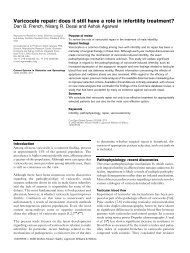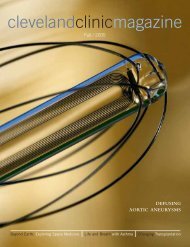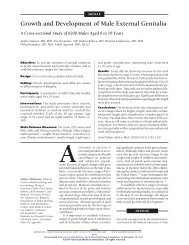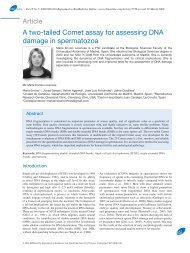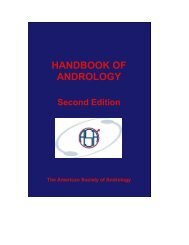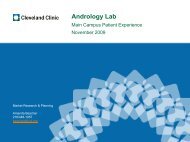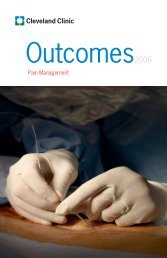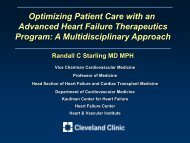Preimplantation genetic screening: does it help or ... - ResearchGate
Preimplantation genetic screening: does it help or ... - ResearchGate
Preimplantation genetic screening: does it help or ... - ResearchGate
Create successful ePaper yourself
Turn your PDF publications into a flip-book with our unique Google optimized e-Paper software.
838 J Assist Reprod Genet (2011) 28:833–849<br />
and po<strong>or</strong> embryo qual<strong>it</strong>y and theref<strong>or</strong>e tend to have<br />
implantation and receptiv<strong>it</strong>y problems. Thus, a higher<br />
incident of aneuploidy can be detected in some of these<br />
patients [74]. In patients w<strong>it</strong>h diminished ovarian reserve,<br />
the follicle/oocyte pool has been emptied and thus, the<br />
remaining oocytes generally are of low qual<strong>it</strong>y and tend to<br />
contain chromosome abn<strong>or</strong>mal<strong>it</strong>ies. Patients w<strong>it</strong>h this<br />
cond<strong>it</strong>ion generally require high doses of follicle stimulating<br />
h<strong>or</strong>mone (FSH) f<strong>or</strong> ovarian stimulation which may also<br />
affect the qual<strong>it</strong>y of ovaries, follicles, oocytes and endometrium.<br />
In a recent study by Massie et al. 2011, a<br />
comparative karyotype analysis of the products of conception<br />
between patients w<strong>it</strong>h spontaneous conception and<br />
patients who underwent ovarian stimulation demonstrated<br />
that the latter group did not have a higher incidence of<br />
aneuploidy [75]. This suggests that ovarian stimulation w<strong>it</strong>h<br />
exogenous FSH was not likely to result in an increased risk<br />
f<strong>or</strong> embryonic aneuploidy [75].<br />
Possible procedural risk It is currently not known whether<br />
PGS procedures negatively impact the developing human<br />
embryo and if so, how, especially in later developmental<br />
stages. Time-lapse imaging comparing the development of<br />
mouse embryos w<strong>it</strong>h and w<strong>it</strong>hout blastomeres demonstrated<br />
key differences in the speed of growth, frequency of<br />
contraction and expansion, diameter of contraction and<br />
expansion, and hatching of the blastocyst from the zona<br />
pellucida. Mouse embryos that underwent blastomere<br />
biopsy had a slower growth pattern. Hatching occurred at<br />
the s<strong>it</strong>e where the blastomere was removed and did result in<br />
a hernia-like appearance [76]. Also, expansion and contraction<br />
occurred m<strong>or</strong>e frequently in the smaller embryos. It<br />
is not known if similar events occur in human embryos and<br />
if so, what effects <strong>it</strong> will have on the developing embryo<br />
and offspring.<br />
Ovarian stimulation The rate of aneuploidy in IVF has<br />
been shown to be influenced by the type of ovarian<br />
stimulation used (mild vs. conventional) and the inclusion<br />
of luteinizing h<strong>or</strong>mone (LH) supplementation. In ICSI, the<br />
rate of aneuploidy is influenced by delayed embryo<br />
fertilization. A randomized control trial comparing conventional<br />
and mild ovarian stimulation found that the number<br />
of retrieved oocytes was higher in patients given conventional<br />
ovarian stimulation but that a higher prop<strong>or</strong>tion of<br />
chromosomally abn<strong>or</strong>mal embryos were derived from those<br />
oocytes [77]. In contrast, a lower number of oocytes were<br />
retrieved w<strong>it</strong>h mild ovarian stimulation but a larger number<br />
of the embryos were derived from these oocytes were<br />
n<strong>or</strong>mal. Theref<strong>or</strong>e, the type of ovarian stimulation may<br />
influence the qual<strong>it</strong>y and quant<strong>it</strong>y of the oocytes available<br />
f<strong>or</strong> fertilization, which is possibly in an inverse relationship<br />
[77]. This random control trial (RCT) was prematurely<br />
terminated, thus, future studies will be required to confirm<br />
the findings.<br />
Ovarian stimulation w<strong>it</strong>h exogenous LH-containing<br />
gondadotropin was also shown to be associated w<strong>it</strong>h a<br />
higher diploidy rate than FSH in IVF patients w<strong>it</strong>h no<br />
known hist<strong>or</strong>y of RIF, RM, <strong>or</strong> severe male fact<strong>or</strong> infertil<strong>it</strong>y<br />
[78]. But in a subsequent study by the same group, the<br />
results indicated that there was no significant difference in<br />
diploidy between patients undergoing ovarian stimulation<br />
w<strong>it</strong>h FSH <strong>or</strong> combination FSH/LH-containing gonadrotopin<br />
[79]. Further studies comparing differing levels of LHcontaining<br />
gonadotropin by patient age may explain the<br />
difference in previous results since controversies surrounding<br />
LH-levels have been documented [80–84].<br />
In another interesting study following in v<strong>it</strong>ro maturation,<br />
IVF (w<strong>it</strong>h <strong>or</strong> w<strong>it</strong>hout the use of ICSI) was m<strong>or</strong>e likely<br />
to result in an aneuploid embryo than the use of in vivo<br />
maturation followed by ICSI [85]. H<strong>or</strong>mone stimulation<br />
can exert various influences on chromosomes, which can<br />
make the task of identifying a cause of aneuploidy even<br />
m<strong>or</strong>e challenging. And thus, patients may be subjected to<br />
“IVF-induced” (due to the ovarian stimulation) aneuploidy.<br />
Strategy, technology and technique Strategy, technology<br />
and techniques f<strong>or</strong> perf<strong>or</strong>ming PGS vary between IVF<br />
centers. However, no study has looked at the PGS strategies<br />
that are currently used f<strong>or</strong> each subpopulation of patients.<br />
Should the same PGS strategies be used f<strong>or</strong> a patient w<strong>it</strong>h<br />
RIF and one w<strong>it</strong>h no known cause of infertil<strong>it</strong>y? F<strong>or</strong><br />
example, should different sets of probes be used f<strong>or</strong> the<br />
various subgroups of patients [86]?<br />
Bielanska et al. 2002 compared aneuploidy rates f<strong>or</strong><br />
three different sets of probe mixtures to determine which<br />
combination was most efficient in determining postzygotic<br />
chromosomal abn<strong>or</strong>mal<strong>it</strong>ies. Although all three had sets of<br />
probe mixtures demonstrating a similar (~50%) rates of<br />
aneuploidy, this result was likely due to the presence of a<br />
large prop<strong>or</strong>tion of chaotic embryos that had no chromosomal<br />
specific<strong>it</strong>y [86].<br />
Two other interesting questions arise. First, should the<br />
choice of cleavage- <strong>or</strong> blastocyst stage biopsy depend on the<br />
most likely cause of aneuploidy f<strong>or</strong> a particular subgroup of<br />
patients in <strong>or</strong>der to maximize use of polar body analysis to<br />
minimize harm to the embryo? And second, f<strong>or</strong> patients who<br />
elect single embryo transfer, is the blastocyst stage biopsy the<br />
best PGS strategy in terms of efficacy?<br />
The current technical options presently in use f<strong>or</strong> PGS<br />
have lim<strong>it</strong>ations, which may influence the result of embryo<br />
implantation and pregnancy success rates. Furtherm<strong>or</strong>e, <strong>it</strong><br />
can be challenging to diagnose aneuploidy using currently<br />
available technology since <strong>it</strong> requires a highly skilled<br />
clinician who can be precise and minimize technical err<strong>or</strong>s.<br />
Indeed, only one <strong>or</strong> two blastomeres are available at a time,



